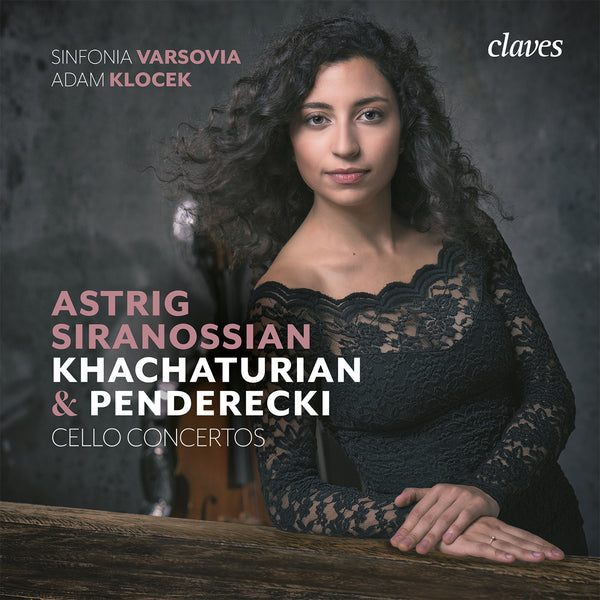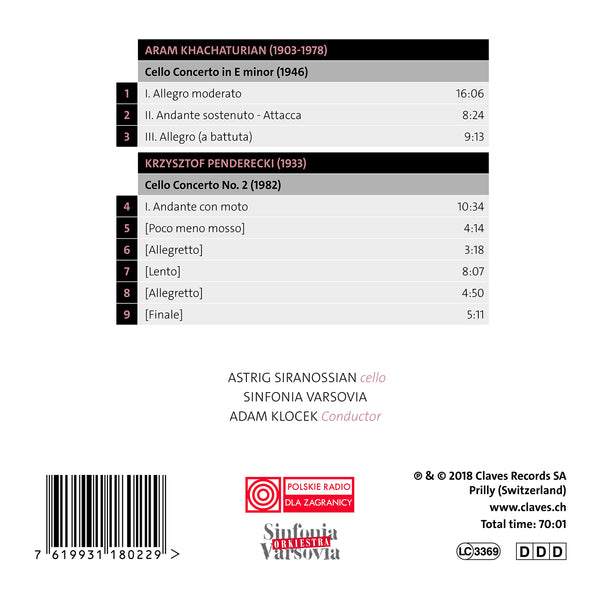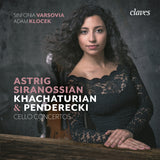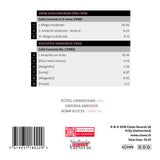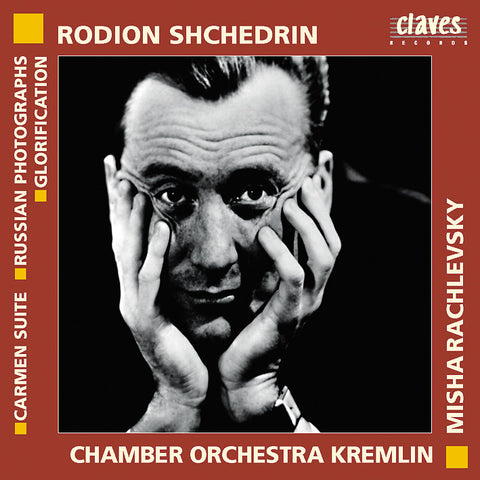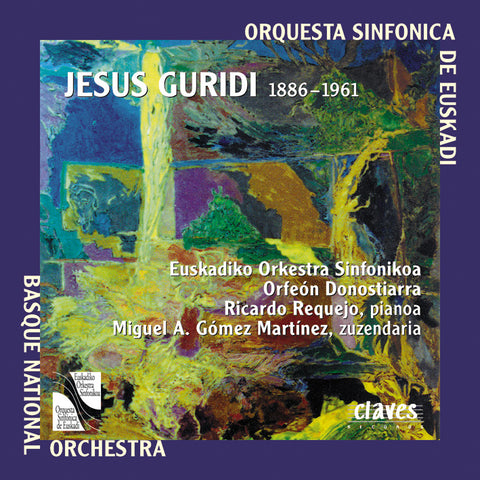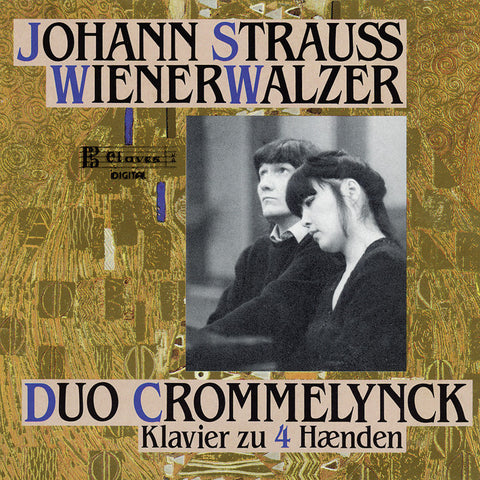(2018) Khachaturian & Penderecki Cello Concertos - Astrig Siranossian, Cello
Catégorie(s): Concerto Orchestral
Instrument(s): Violoncelle
Compositeur principal: Aram Khatchaturian
Orchestre: Sinfonia Varsovia
Chef: Adam Klocek
Nb CD(s): 1
N° de catalogue:
CD 1802
Sortie: 16.03.2018
EAN/UPC: 7619931180229
Cet album est en repressage. Précommandez-le dès maintenant à un prix spécial.
CHF 18.50
Cet album n'est plus disponible en CD.
Cet album n'est pas encore sorti. Précommandez-le dès maintenant.
CHF 18.50
Cet album n'est plus disponible en CD.
CHF 18.50
TVA incluse pour la Suisse et l'UE
Frais de port offerts
Cet album n'est plus disponible en CD.
TVA incluse pour la Suisse et l'UE
Frais de port offerts
Cet album est en repressage. Précommandez-le dès maintenant à un prix spécial.
CHF 18.50
Cet album n'est plus disponible en CD.
This album has not been released yet.
Pre-order it at a special price now.
CHF 18.50
Cet album n'est plus disponible en CD.
CHF 18.50
Cet album n'est plus disponible en CD.
KHACHATURIAN & PENDERECKI CELLO CONCERTOS - ASTRIG SIRANOSSIAN, CELLO
*** Clé d'Or ResMusica 2018 ***
KHACHATURIAN CONCERTO
First performed on 30th October 1946 in the Great Hall of the Moscow Conservatory in the very midst of the Soviet turmoil, the Cello Concerto was the last of a series of three concertos, such as those for violin or piano, to be presented with Sviatoslav Knouchevitski (dedicatee) on the cello and Aleksandr Gauk conducting. Though first performed in 1946, it was written many years earlier while the composer was studying cello at the Gnessin Institute. The “Stalin Prize” (1941) for his First Violin Concerto (that contributed to his international fame) as well as his Third Symphony, first performed in 1947 for the thirtieth anniversary of the October Revolution, did not prevent him, following the 1948 Zhdanov Decree, to be accused - as were Prokofiev and Shostakovich - of writing hermetic, formalist music with misunderstood dissonances. Being barred from the Union of Soviet Composers left a strong mark on the three friends.
The Cello Concerto in E minor is a reflexion of Khachaturian’s early love of the opera. Often described as a “Symphonie Concertante”, it features the rhythmic, melodic, virtuoso and popular aspects of music of the period. The long cadenza of the first movement precedes the “Sonata-Fantasia” for cello solo by Khachaturian published in 1974 and includes several Caucasian themes that are closely related to the history of his family.
In 1962 he wrote, in collaboration with Mstislav Rostropovich, a Concerto Rhapsody in a less lyrical language, opening the way for a more avant-garde style of writing for the cello which is undeniably found in Penderecki’s Second Concerto.
PENDERECKI CELLO CONCERTO N°2
First performed in 1982 by Mstislav Rostropovich, Penderecki’s Second Concerto for Cello and Orchestra is composed in one single movement: its architectural vision - in an arch style, including several cadenzas for the solo instrument - maintains a dramatic atmosphere throughout the work. The composer, having been a forerunner in the use of classical instruments as percussion in serial writing in the 60s, returned however to a post-romantic language in the 80s. As in several of these cello pieces, Penderecki builds on the heritage of the percussive use of this instrument (his First Cello Concerto created in 1972 is a perfect example of this) and heralds a new period inspired by his liking for sacred music.
Rather like Khachaturian but in a more avant-garde language, the idea of dramatisation is very present in this Second Cello Concerto. The use of clusters, glissandi, rests, masses of sound and immersion of extremely tonal passages create a stage set for this work. Indeed it is no wonder that Penderecki’s music was used in many films such as “The Exorcist” by William Peter Blatty in 1973, Stanley Kubrick’s “The Shining” in 1980, or Martin Scorsese’s “Shutter Island” in 2010. With these two works, Khachaturian and Penderecki offer a most complete vision of the use of the cello as solo instrument, supported by very dense orchestration.
ASTRIG SIRANOSSIAN
www.astrigsiranossian.com
Winner of the First Prize and several times winner of the Special Prize of the Krzysztof Penderecki International Cello Competition, Astrig Siranossian performs as soloist with famous orchestras. A regular guest of Daniel Barenboim’s, her musical partners are no less than Simon Rattle, Antonio Pappano, Yo-Yo Ma, Sol Gabetta, Bertrand Chamayou, Daniel Ottensamer... The most well-known venues have already hosted the young musician: Paris Philharmonic, Musikverein in Vienna, KKL Luzern, Basel Casino, Dijon Opera, Flagey in Brussels, Teatro Colon Buenos Aires, Kennedy Center Washington....
The recording made in 2016 by the Claves Records label and dedicated to Gabriel Fauré, Francis Poulenc and Komitas was greatly acclaimed by critics, including the Musica Prize. She obtained a “coup de coeur” by the French-speaking Belgian Radio-Television during the 2017 Queen Elisabeth competition.
Astrig Siranossian has been artist in residence since 2015 at the Queen Elisabeth Music Chapel as well as the Singer-Polignac Foundation. She has recorded a chamber music CD with the Évidence label dedicated to Franz Schubert, which will be published in 2018. In 2016, she became Artistic Director of the Musicades Romanesques, festival of the town of Romans that mirrors music with art as well as with gastronomy.
Astrig Siranossian started music at the age of three. Five years later she was admitted to the CNR in Lyon, furthered her studies at the Lyon CNSM in Lyon, obtaining her diploma of higher studies with distinction. She completed her training in Switzerland at the Basel Conservatory in Ivan Monighetti’s class, passing her Concert Masters and Soloist Masters Degree with flying colours.
Astrig plays a 1676 Ruggieri cello, generously loaned by the Boubo Music Foundation in Binningen.
SINFONIA VARSOVIA ORCHESTRA
“... work with no other orchestra has ever given me as much satisfaction as my work as soloist and conductor for the Sinfonia Varsovia Orchestra.”
Yehudi Menuhin - 29 August, 1991
In April of 1984, Waldemar Dąbrowski, director of the St. I. Witkiewicz Studio Centre for the Arts in Warsaw and Franciszek Wybrańczyk, director of the then extant Polish Chamber Orchestra invited the legendary violinist Sir Yehudi Menuhin to perform in Poland as soloist and conductor. To match the exigencies of the planned repertoire, the orchestra increased the number of its members, inviting renowned musicians from all over Poland to perform together. The ensemble’s initial concerts under the direction of Yehudi Menuhin were enthusiastically applauded by audiences and praised by critics, while Lord Menuhin himself did not hesitate to accept Waldemar Dąbrowski’s and Franciszek Wybrańczyk’s proposal to become the first guest conductor of the newly established symphony orchestra named Sinfonia Varsovia.
ADAM KLOCEK
Grammy Award winning conductor and cellist born in 1973 in Cracow, described by Krzysztof Penderecki as “one of most talented conductors of the younger generation”.
Adam Klocek by winning an international competition assumed position of General and Music Director of the Great-Poland Philharmonic in Kalisz, Poland. In 2004 Klocek won the conducting competition at Wroclaw Philharmonic and assumed position of assistant to Maestro Jan Latham-Koenig – music director of the orchestra and of the International “Vratislavia Cantans” Festival. He was also guest conductor of the symphony orchestra in Arizona. Since 2012 Adam Klocek has been music director of the Huberman Philharmonic Orchestra in Czestochowa, Poland. One year earlier he assumed position of music director of Young Polish Philharmonic Orchestra – national youth symphony orchestra of Poland. His interests and talent for conducting were revealed very early by Polish conductor Jerzy Maksymiuk.
Adam Klocek conducted a professional orchestra for the first time at the age of 10. Two years later he made his debut with the Baltic Philharmonic and Cracow Academy of Music Orchestra conducting works by Mozart, Beethoven and Ives. The main course of his activity, however, became playing the cello he had started to learn at the age of 7. He studied at Hochschule fur Musik in Cologne and Hanns Eisler Hochschule fur Musik in Berlin with Maria Kliegel and Boris Pergamenschikow. During his career as a conductor he has performed with all major Polish orchestras eg. Sinfonia Varsovia, National Philharmonic Warsaw, the Polish Chamber Orchestra, the Cracow Philharmonic Orchestra, the Wroclaw Philharmonic Orchestra, the A. Rubinstein Philharmonic, the Baltic Philharmonic and many others. Klocek performed with such artists as: Heinrich Schiff, Krzysztof Penderecki, Sophia Gubaidulina, Witold Lutosławski, Vadim Repin, Evelyn Glennie.
*** Clé d'Or ResMusica 2018 ***
KHACHATURIAN CONCERTO
First performed on 30th October 1946 in the Great Hall of the Moscow Conservatory in the very midst of the Soviet turmoil, the Cello Concerto was the last of a series of three concertos, such as those for violin or piano, to be presented with Sviatoslav Knouchevitski (dedicatee) on the cello and Aleksandr Gauk conducting. Though first performed in 1946, it was written many years earlier while the composer was studying cello at the Gnessin Institute. The “Stalin Prize” (1941) for his First Violin Concerto (that contributed to his international fame) as well as his Third Symphony, first performed in 1947 for the thirtieth anniversary of the October Revolution, did not prevent him, following the 1948 Zhdanov Decree, to be accused - as were Prokofiev and Shostakovich - of writing hermetic, formalist music with misunderstood dissonances. Being barred from the Union of Soviet Composers left a strong mark on the three friends.
The Cello Concerto in E minor is a reflexion of Khachaturian’s early love of the opera. Often described as a “Symphonie Concertante”, it features the rhythmic, melodic, virtuoso and popular aspects of music of the period. The long cadenza of the first movement precedes the “Sonata-Fantasia” for cello solo by Khachaturian published in 1974 and includes several Caucasian themes that are closely related to the history of his family.
In 1962 he wrote, in collaboration with Mstislav Rostropovich, a Concerto Rhapsody in a less lyrical language, opening the way for a more avant-garde style of writing for the cello which is undeniably found in Penderecki’s Second Concerto.
PENDERECKI CELLO CONCERTO N°2
First performed in 1982 by Mstislav Rostropovich, Penderecki’s Second Concerto for Cello and Orchestra is composed in one single movement: its architectural vision - in an arch style, including several cadenzas for the solo instrument - maintains a dramatic atmosphere throughout the work. The composer, having been a forerunner in the use of classical instruments as percussion in serial writing in the 60s, returned however to a post-romantic language in the 80s. As in several of these cello pieces, Penderecki builds on the heritage of the percussive use of this instrument (his First Cello Concerto created in 1972 is a perfect example of this) and heralds a new period inspired by his liking for sacred music.
Rather like Khachaturian but in a more avant-garde language, the idea of dramatisation is very present in this Second Cello Concerto. The use of clusters, glissandi, rests, masses of sound and immersion of extremely tonal passages create a stage set for this work. Indeed it is no wonder that Penderecki’s music was used in many films such as “The Exorcist” by William Peter Blatty in 1973, Stanley Kubrick’s “The Shining” in 1980, or Martin Scorsese’s “Shutter Island” in 2010. With these two works, Khachaturian and Penderecki offer a most complete vision of the use of the cello as solo instrument, supported by very dense orchestration.
ASTRIG SIRANOSSIAN
www.astrigsiranossian.com
Winner of the First Prize and several times winner of the Special Prize of the Krzysztof Penderecki International Cello Competition, Astrig Siranossian performs as soloist with famous orchestras. A regular guest of Daniel Barenboim’s, her musical partners are no less than Simon Rattle, Antonio Pappano, Yo-Yo Ma, Sol Gabetta, Bertrand Chamayou, Daniel Ottensamer... The most well-known venues have already hosted the young musician: Paris Philharmonic, Musikverein in Vienna, KKL Luzern, Basel Casino, Dijon Opera, Flagey in Brussels, Teatro Colon Buenos Aires, Kennedy Center Washington....
The recording made in 2016 by the Claves Records label and dedicated to Gabriel Fauré, Francis Poulenc and Komitas was greatly acclaimed by critics, including the Musica Prize. She obtained a “coup de coeur” by the French-speaking Belgian Radio-Television during the 2017 Queen Elisabeth competition.
Astrig Siranossian has been artist in residence since 2015 at the Queen Elisabeth Music Chapel as well as the Singer-Polignac Foundation. She has recorded a chamber music CD with the Évidence label dedicated to Franz Schubert, which will be published in 2018. In 2016, she became Artistic Director of the Musicades Romanesques, festival of the town of Romans that mirrors music with art as well as with gastronomy.
Astrig Siranossian started music at the age of three. Five years later she was admitted to the CNR in Lyon, furthered her studies at the Lyon CNSM in Lyon, obtaining her diploma of higher studies with distinction. She completed her training in Switzerland at the Basel Conservatory in Ivan Monighetti’s class, passing her Concert Masters and Soloist Masters Degree with flying colours.
Astrig plays a 1676 Ruggieri cello, generously loaned by the Boubo Music Foundation in Binningen.
SINFONIA VARSOVIA ORCHESTRA
“... work with no other orchestra has ever given me as much satisfaction as my work as soloist and conductor for the Sinfonia Varsovia Orchestra.”
Yehudi Menuhin - 29 August, 1991
In April of 1984, Waldemar Dąbrowski, director of the St. I. Witkiewicz Studio Centre for the Arts in Warsaw and Franciszek Wybrańczyk, director of the then extant Polish Chamber Orchestra invited the legendary violinist Sir Yehudi Menuhin to perform in Poland as soloist and conductor. To match the exigencies of the planned repertoire, the orchestra increased the number of its members, inviting renowned musicians from all over Poland to perform together. The ensemble’s initial concerts under the direction of Yehudi Menuhin were enthusiastically applauded by audiences and praised by critics, while Lord Menuhin himself did not hesitate to accept Waldemar Dąbrowski’s and Franciszek Wybrańczyk’s proposal to become the first guest conductor of the newly established symphony orchestra named Sinfonia Varsovia.
ADAM KLOCEK
Grammy Award winning conductor and cellist born in 1973 in Cracow, described by Krzysztof Penderecki as “one of most talented conductors of the younger generation”.
Adam Klocek by winning an international competition assumed position of General and Music Director of the Great-Poland Philharmonic in Kalisz, Poland. In 2004 Klocek won the conducting competition at Wroclaw Philharmonic and assumed position of assistant to Maestro Jan Latham-Koenig – music director of the orchestra and of the International “Vratislavia Cantans” Festival. He was also guest conductor of the symphony orchestra in Arizona. Since 2012 Adam Klocek has been music director of the Huberman Philharmonic Orchestra in Czestochowa, Poland. One year earlier he assumed position of music director of Young Polish Philharmonic Orchestra – national youth symphony orchestra of Poland. His interests and talent for conducting were revealed very early by Polish conductor Jerzy Maksymiuk.
Adam Klocek conducted a professional orchestra for the first time at the age of 10. Two years later he made his debut with the Baltic Philharmonic and Cracow Academy of Music Orchestra conducting works by Mozart, Beethoven and Ives. The main course of his activity, however, became playing the cello he had started to learn at the age of 7. He studied at Hochschule fur Musik in Cologne and Hanns Eisler Hochschule fur Musik in Berlin with Maria Kliegel and Boris Pergamenschikow. During his career as a conductor he has performed with all major Polish orchestras eg. Sinfonia Varsovia, National Philharmonic Warsaw, the Polish Chamber Orchestra, the Cracow Philharmonic Orchestra, the Wroclaw Philharmonic Orchestra, the A. Rubinstein Philharmonic, the Baltic Philharmonic and many others. Klocek performed with such artists as: Heinrich Schiff, Krzysztof Penderecki, Sophia Gubaidulina, Witold Lutosławski, Vadim Repin, Evelyn Glennie.
Return to the album | Read the booklet | Composer(s): Aram Khatchaturian | Main Artist: Astrig Siranossian





STUDIO MASTER (AUDIO HAUTE-RÉSOLUTION)
Adam Klocek
Albums populaires
Amethys Design
Aram Khatchaturian (1903-1978)
Astrig Siranossian - cello
Classica - Coup de coeur
Claves picks
Clé d'Or ResMusica
Clé du mois - ResMusica
Concerto
En stock
ICMA 2019
Joker - Crescendo Magazine
Krzysztof Penderecki
Musique Haute-résolution - Qualité master studio
Orchestral
Preis der Deutschen Schallplatten Kritik - Besten Listen
Sinfonia Varsovia
Tous les albums
Télérama 4F
Violoncelle
Adam Klocek
Albums populaires
Amethys Design
Aram Khatchaturian (1903-1978)
Astrig Siranossian - cello
Classica - Coup de coeur
Claves picks
Clé d'Or ResMusica
Clé du mois - ResMusica
Concerto
En stock
ICMA 2019
Joker - Crescendo Magazine
Krzysztof Penderecki
Musique Haute-résolution - Qualité master studio
Orchestral
Preis der Deutschen Schallplatten Kritik - Besten Listen
Sinfonia Varsovia
Tous les albums
Télérama 4F
Violoncelle
















